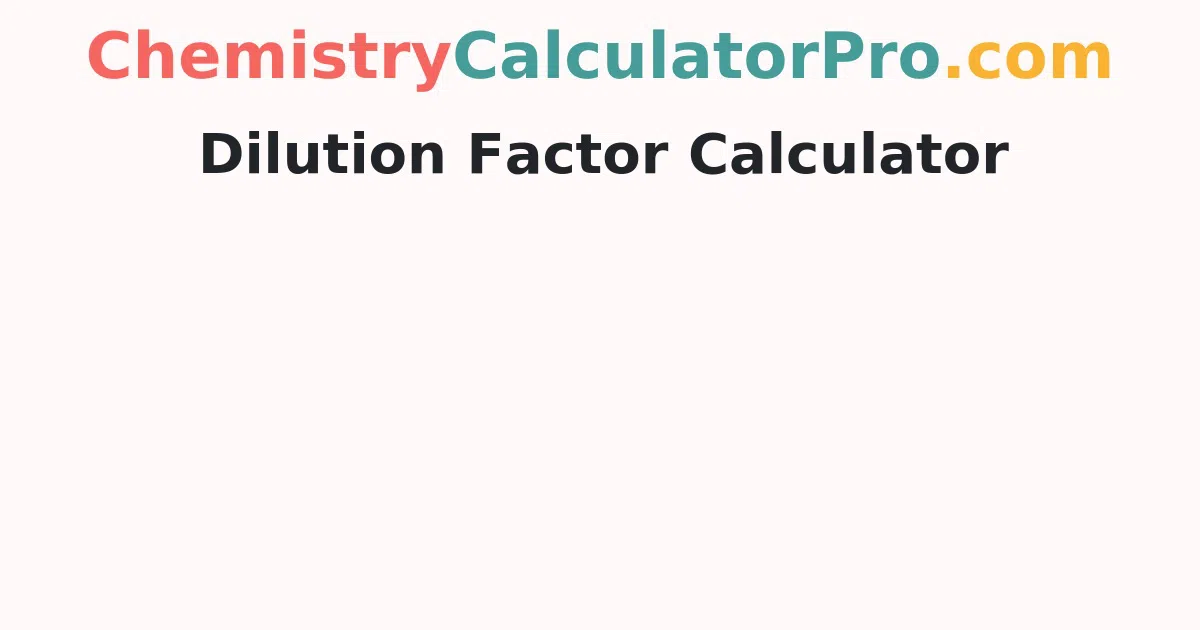Dilution Factor Calculator
Using the solution original volume and diluted volume, the Dilution Factor Calculator calculates the total to stock, dilutant to stock, and total to the stock of the solution. Simply enter the diluted volume and initial volume as inputs and press the calculate button to get the dilution factors as an output.
What is a Dilution Factor?
After dilution, the dilution factor is the notation used to describe how much of the original stock solution remains in the final solution. It's written as a ratio or an exponent. The dilution factor is the proportion of stock solution to diluted added or stock solution to total solution.
Dilution Factor Formula
The following are the dilution factor formulas
- S:D = stock volume : diluted volume
- S:T = Stock volume : total volume
How can you find out the Dilution Factor?
The procedure for determining a dilution's dilution factor is described here.
- Step 1: Know the solution's stock volume and dilutant volume.
- Step 2: To get the final volume, multiply the initial volume by the dilutant volume.
- Step 3: The ratio of final volume to stock volume is known as total to stock.
- Step 4: The ratio of dilutant volume to stock volume is known as dilutant to stock.
How Do I Use the Dilution Calculator?
The following is the procedure how to use the dilution calculator
- Step 1: In the appropriate input fields, enter the volume, the concentration of the solution before dilution, and the unknown value as "x."
- Step 2: To receive the result, click the "Calculate X and Volume of Solvent" button.
- Step 3: In the output field, the volume of the concentration after dilution and the value of x will be presented.
Dilution Factor Examples
Question 1: A chemist dilutes a stock solution with a volume of 7 m^3. Find the dilution factors for a dilutant volume of 9 m^3.
Solution:
Given:
Stock volume = 7 m^3
Dilutant volume = 9 m^3
Final volume = stock volume + dilutant volume
= 7 + 9 = 16
Total Stock = total volume/stock volume
= 16/7 = 2.28
Dilutant Stock = dilutant volume/stock volume
= 9/7 = 1.28
FAQ’s on Dilution Factor Calculator
1. How do you find out the concentration using the dilution factor?
We multiply by the inverse of our dilution factor to get the concentration of our diluted sample. We often wish we could work backwards. Let's pretend we have a 1/5 diluted sample with a concentration of 0.60 M.
2. What is the purpose of calculating the dilution factor?
After dilution, the dilution factor (or dilution ratio) is used to represent how much of the original stock solution remains in the entire solution. However, because this solution is too concentrated for your experiment, you add 90 cm3 of water to dilute it further.
3. What are dilution factors and how do they work?
The dilution factor can alternatively be represented as the ratio of the volume of the final diluted solution to the volume of the stock solution before it was diluted. The dilution factor is 10 when 100 mL of a stock solution is diluted with solvent/diluent to a total final volume of 1000 mL.
4. How can you distinguish between diluted and undiluted concentrations?
Simply multiply the concentration of the undiluted, unknown sample by the dilution factor to get the concentration. As a result, 0.5 x 10 = 5 mg/ml.
5. What does the term "dilution" mean?
Dilution is the process of lowering the concentration of solutes in a solution. This is accomplished by increasing the amount of solvent in the solution. The dilution process is when an acid or a base is mixed with water to reduce the concentration of ions in a solution.
